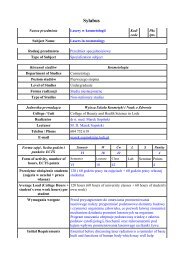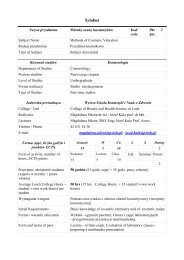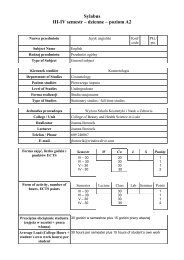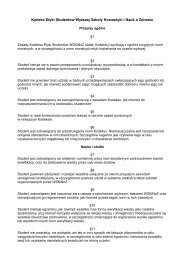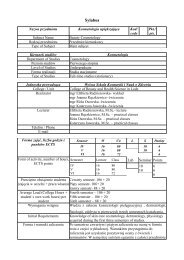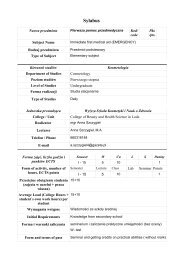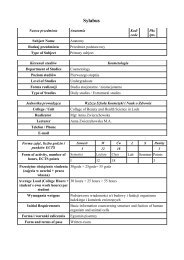Sylabus - Kosmetologia
Sylabus - Kosmetologia
Sylabus - Kosmetologia
You also want an ePaper? Increase the reach of your titles
YUMPU automatically turns print PDFs into web optimized ePapers that Google loves.
Teaching aims (knowledge, skills,social competence)2. Rozwinięcie umiejętności:• doboru właściwych preparatów kosmetycznych dookreślonych zabiegów pielęgnacyjnych• prowadzenia terapii zabiegowych na twarz i ciało zuwzględnieniem rytuałów Spa&Wellness• stosowania terapii skojarzeniowych Spa&Wellness• prowadzenia różnych technik masażu relaksacyjnego• prowadzenia konsultacji Spa, prawidłowej diagnostykiskóry, rekomendacji preparatów do pielęgnacji domowej.3. Rozwinięcie umiejętności komunikacji i pracy w grupieoraz nabycie postawy otwartości i wrażliwości na potrzebyfizyczne, psychiczne i emocjonalne klientów Spa.1. Imparting the knowledge of:• Spa history• Contemporary spa trends in Poland and abroad• Principles and elements of Wellness• Different Spa & Wellness techniques and methods of treatment• Combining various Spa & Wellness therapies,• Thermotherapy, hydrotherapy, balneotherapy, peloidotherapy,paraffin therapy• Characteristics of selected cosmetic preparations• The impact of stress on the human body and the skin• The fundamentals of dietetics• The fundamentals of managing a Spa centre• Health and safety rules at a Spa centre2. Developing skills in:• selecting appropriate cosmetic preparations for specific skincare treatments• conducting face and body treatments with the use of the Spa &Wellness rituals• applying Spa & Wellness associative therapies• carrying out different techniques of relaxation massage• Spa consultations, correct skin diagnosis, recommending homeskin care preparations.3. Developing communication skills and the ability to work in agroup, taking on the attitudes of openness and sensitivity to thephysical, mental and emotional needs of Spa clients.Program ramowy przedmiotuWYKŁADY:1. Spa w starożytności, w czasach nowożytnych, współczesne(day spa, resort spa, centrum odnowy biologicznej, sanatoria,uzdrowiska, medical spa)2. Przykładowe centra Spa na świecie i w Polsce3. Fizjologia stresu. Pojęcie stresu i jego wpływ na ciało, umysł,emocje. Procesy starzenia się organizmu, chorobycywilizacyjne a stres. Wpływ stresu na rozwój zmianskórnych.4. Dysmorfofobia5. Świat saun (tepidarium, hamman, sauna sucha, sauna parowa,kabiny infrared) – charakterystyka, wskazania i
przeciwwskazania, metodyka6. Parafinoterapia – metodyka, wskazania i przeciwwskazania7. Hydroterapia – metodyka, wskazania i przeciwwskazania.Charakterystyka urządzeń do hydroterapii8. Balneologia – wskazania i przeciwwskazania9. Peloidoterapia – charakterystyka, wskazania iprzeciwwskazania.10. Dietetyka i żywienie w obiektach Spa & Wellness.Omówienie podstaw zdrowego żywienia11. Suplementacja dostosowana do indywidualnych potrzebklienta12. Ayurveda w ośrodkach Spa. Zasady medycynyAyurvedyjskiej i jej pozycja we współczesnym świecie.Pielęgnacja skóry zgodnie z zaleceniami Ayurvedy. Ayurvedaa dieta.13. Zajęcia poprawiające kondycję fizyczną w ośrodkachSpa&Wellness14. Psychologia w Spa. Komunikacja interpersonalna.Typologia klientów.15. Zarządzanie Spa. Budowanie oferty Spa. Programylojalnościowe. Wybór docelowej grupy klientów. Tworzenieoferty komercyjnej. Promocja ośrodka.ĆWICZENIA:1. Filozofia Wellness: zasady i elementy – omówienie, dyskusjaoraz praktyczne zastosowanie2. Podejście holistyczne w ośrodku Spa&Wellness3. Przykładowe centra realizujące program Spa&Wellness:analiza4. Zasady, techniki oraz etapy wykonywania terapiiSpa&Wellness na twarz i ciało5. Światowe techniki masażu – charakterystyka, demonstracjawybranych.6. Praktyczna nauka:• masażu relaksującego na ciało• fazy powitania do zabiegów na ciało• rytuału peelingowania skóry ciała• masażu relaksacyjnego twarzy, szyi, dekoltu i głowy• masażu gorącymi kamieniami• masażu stemplami7. Aromaterapia - fizjologia i psychologia zapachu, omówieniewybranych olejków8. Praktyczne umiejętności dobierania olejków eterycznychwedług indywidualnych potrzeb klienta9. Zabieg na ciało – charakterystyka zabiegu, wskazania iprzeciwwskazania, omówienie produktów do zabiegu,metodyka zabiegu10. Terapie skojarzeniowe w ośrodku Spa&Wellness11. Zastosowanie sauny suchej i parowej w terapiachSpa&Wellness12. Zastosowanie jacuzzi w terapiach Spa&Wellness13. Karta konsultacyjna w Spa – wskazania, przeciwwskazania,metodyka zabiegów, omówienie różnych przypadków
14. Masaż podwodny – wskazania, przeciwwskazania,metodyka zabiegu15. Bicze szkockie – wskazania, przeciwwskazania, metodykazabiegu16. Krioterapia miejscowa – demonstracja17. Terapie Spa&Wellness na twarz18. Zastosowanie thalassoterapii w zabiegach na twarz i ciałoOverall teaching PlanLECTURES:1. Spa in ancient times, in modern times, today (day spa, resortspa, health and beauty spa, sanatorium, health-resort, medicalspa)2. Examples of Spa centres in the world and in Poland3. Physiology of stress. The notion of stress and its effects on thebody, mind and emotions. The connection between the processesof body aging, diseases of civilization and stress.The effects of stress on the development of skin changes.4. Dysmorphophobia5. The world of saunas (tepidarium, Turkish bath, Finnish sauna,steam sauna, infrared cabins) – characteristics, indications andcontraindications, methodology6. Paraffin therapy – methodology, indications andcontraindications8. Hydrotherapy – methodology, indications andcontraindications. Characteristics of hydrotherapy equipment.9. Balneotherapy – indications and contraindications10. Peloidotherapy – characteristics, indications andcontraindications.11. Dietetics and nutrition in Spa & Wellness centres. Discussionon the principles of healthy eating.12. Supplementation tailored to meet individual customer’sneeds.13. Ayurveda in Spa centres. The principles of Ayurvedicmedicine and its position in the contemporary world. Skin careaccording to Ayurveda. The connection between Ayurveda and adiet.14. Activities improving physical condition in Spa & Wellnesscentres.15. Psychology in the Spa centre. Interpersonal communication.Client typology.16. Spa Management. Preparing a spa offer. Customer loyaltyprograms. Selecting target customer group. Creating acommercial offer. Promotion of the spa facility.PRACTICAL CLASSES:1. Philosophy of Wellness: principles and elements - a review,discussion and practical application2. A holistic approach in the Spa & Wellness centre3. The examples of centers carrying out the Spa & Wellnessprogram: the analysis4. Principles, techniques and stages of face and body Spa &Wellness treatments.
Metody dydaktyczneMethodology measuresEfekty kształcenia (wiedza,umiejętności, kompetencjespołeczne)5. World massage techniques – characteristics and demonstrationof the selected ones.6. Practical skills:• relaxing body massage• the welcome phase: the initial phase of body treatments• skin peeling ritual• relaxing massage of the face, neck, and head• hot stone massage• herbal punches massage7. Aromatherapy – physiology and psychology of the scent, areview of selected essential oils8. Practical skills in matching essential oils to individualcustomer’s needs9.Body treatments – characteristics of the procedure, indicationsand contraindications, review of products for the treatment,methodology of the treatment10. Associative therapies at a Spa & Wellness centre11. The use of Finnish and steam saunas in Spa & Wellnesstherapies12. The use of jacuzzi in Spa & Wellness therapies13. Spa consultation card – indications, contraindications,methodology of the treatment, review of different cases14. Underwater massage - indications, contraindications,methodology of the treatment15. Scottish shower – indications, contraindications,methodology of the treatment16. Spa & Wellness treatments for the face17. The use of the thalassotherapy treatments for face and bodyWykład z zastosowaniem rzutnika multimedialnego, ćwiczenia,pokaz, dyskusjaLecture with the use of multimedia projector, practical classes,demonstration, discussionWiedza:• objaśnia historyczne aspekty funkcjonowania Spa, a takżewspółczesne trendy Spa w Polsce i na świecie;• rozumie i wyjaśnia zasady i elementy filozofii Wellness;• rozumie istotę łączenia różnych terapii zabiegowychSpa&Wellness;• definiuje termoterapię, hydroterapię, balneoterapię,peloidoterapię, parafinoterapię;• rozumie wpływ stresu na organizm człowieka, podstawydietetyki oraz podstawy zarządzania ośrodkamiSpa&Wellness;Umiejętności:• rozumie i dobiera różne techniki i metody zabiegoweSpa&Wellness;• wybiera właściwe preparaty kosmetyczne do zabiegów;• prowadzi terapie zabiegowe na twarz i ciało zuwzględnieniem rytuałów Spa&Wellness;• stosuje terapie skojarzeniowe Spa&Wellness;• prowadzi różne techniki masażu relaksacyjnego;
Educational Effects (knowledge,skills, social competence)Literatura podstawowaCore Reading• przeprowadza konsultacje Spa;• prawidłowo interpretuje wyniki diagnostyki skóry;• dobiera preparaty do pielęgnacji domowej;• stosuje zasady bezpieczeństwa i higieny pracy w Spa;Kompetencje społeczne:• obiektywnie ocenia wkład własnej pracy i innych wprzeprowadzonych wspólnie terapiach Spa&Wellness;• jest otwarty i wrażliwy na potrzeby fizyczne, psychiczne iemocjonalne klientów Spa.Knowledge:• explains the historical aspects of the Spa and contemporarySpa trends in Poland and in the world;• understands and explains the principles and elements of theWellness philosophy;• understands the idea of combining different Spa &Wellnesstreatments• defines thermotherapy, hydrotherapy, balneotherapy,peloidotherapy, paraffin therapy;• understands the impact of stress on the human body,fundamentals of dietetics and the fundamentals of managingSpa&Welness centres;Skills:• understands and chooses various Spa &Wellness techniquesand methods of treatment;• selects the appropriate cosmetic preparations for thetreatments;• conducts face and body treatments with the use of Spa &Wellness rituals;• uses associative Spa &Wellness therapies;• uses various relaxation massage techniques;• carries out Spa consultations;• interprets the results of skin diagnostics correctly;• selects preparations for home skin care;• applies the principles of occupational health and safety at theSpa centre;Social competence:• objectively assesses personal contribution and others’ workinput in Spa & Wellness treatments conducted jointly;• is open and responsive to the physical, mental and emotionalneeds of Spa clients.Kasprzak W., Mańkowska A.: Fizykoterapia, medycynauzdrowiskowa i SPA. PZWL, Warszawa 2010.Kasprzak W., Mańkowska A.: Fizjoterapia w kosmetologii imedycynie estetycznej PZWL, Warszawa 2010.Mika T. Kasprzak W. Fizjoterapia. PZWL, Warszawa 2007.Kasprzak W., Mańkowska A.: Physical Therapy, Health Resortand Spa Medicine. PZWL, Warsaw 2010.Kasprzak W., Mańkowska A. Physiotherapy in cosmetology andaesthetic medicine. PZWL, Warsaw 2010.Mika T. Kasprzak W. Physiotherapy. PZWL, Warsaw 2007.
Literatura uzupełniającaAdditional ReadingStraburzyński G., Straburzyńska-Lupa A.: Medycyna fizykalna.PZWL, Warszawa 2000.Noszczyk M. /red./ <strong>Kosmetologia</strong> pielęgnacyjna i lekarska.PZWL, Warszawa 2010.Straburzyński G., Straburzyńska-Lupa A.: Physical Medicine.PZWL, Warsaw 2000.Noszczyk M. /ed./ Skincare and medical cosmetology. PZWL,Warsaw 2010.UwagiRemarksData opracowania 28.06.2012r.Date of Update 28.06.2012......................................................Podpis wykładowcyLecturer`s Signature



